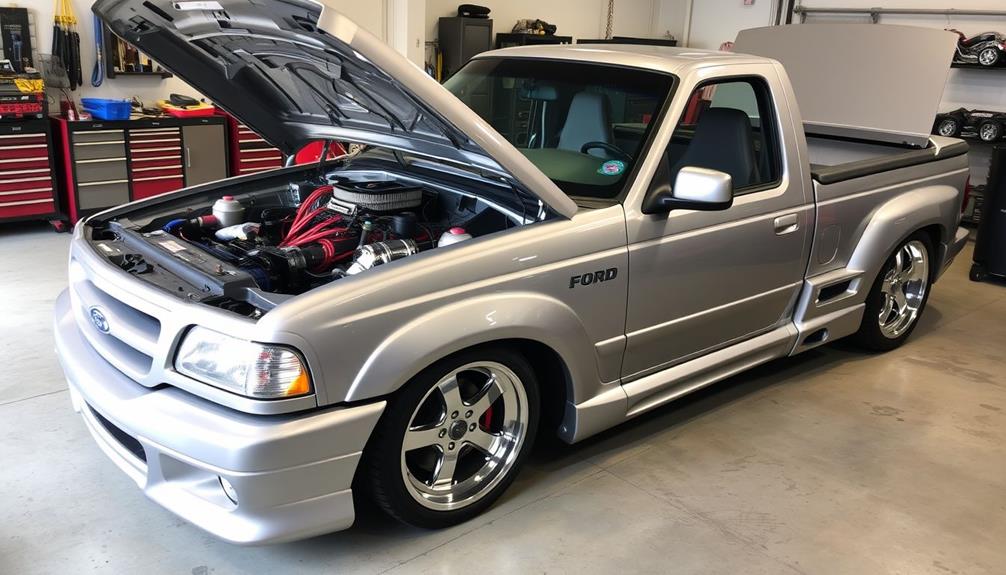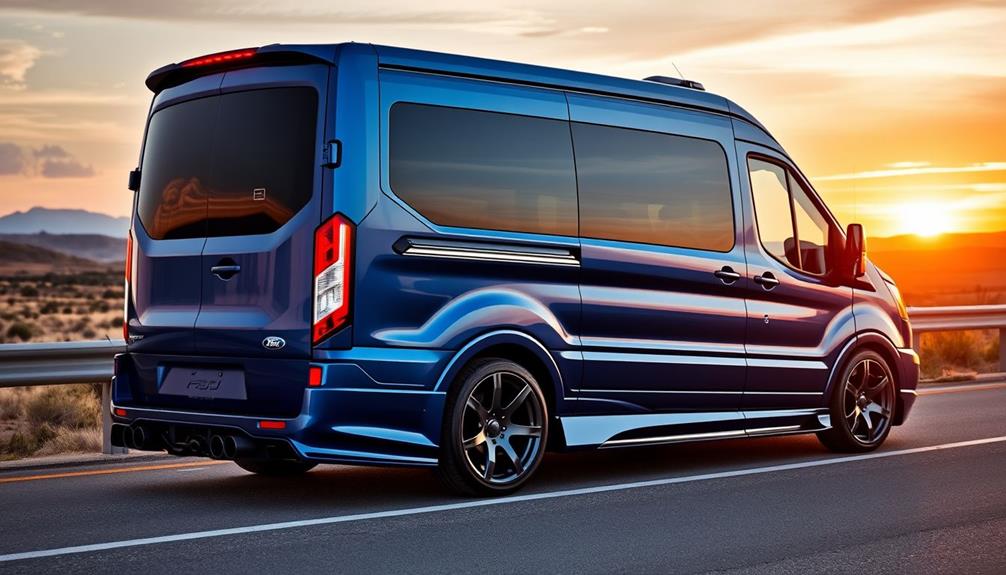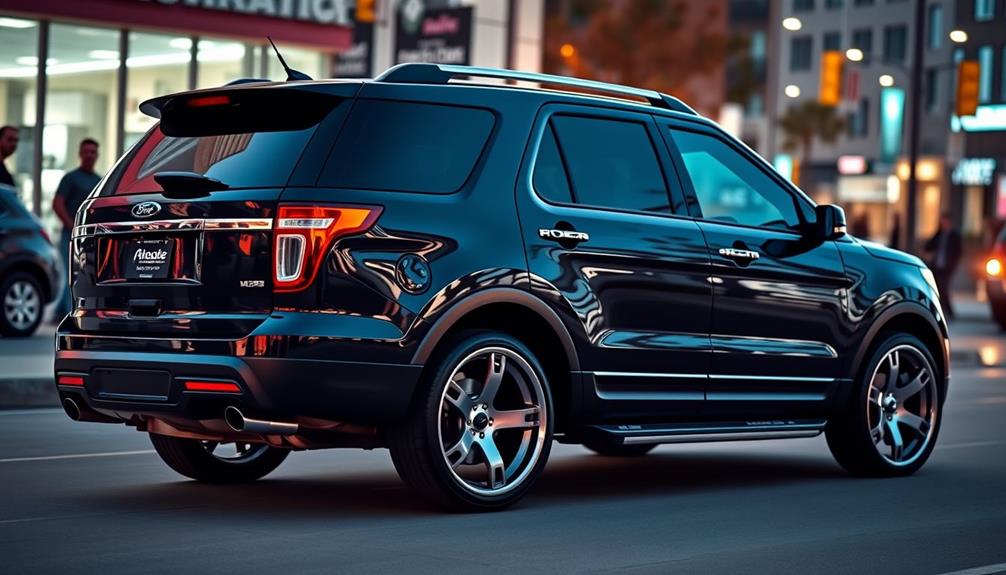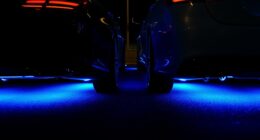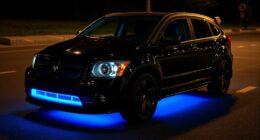Tuning your 2000 Ford Lightning can turn your pickup into a powerhouse. Start with upgrades like a cold air intake and a single blade throttle body to boost airflow and gain horsepower. Consider pulley kits to crank up the boost, along with fuel system enhancements to support high performance. Don't forget about exhaust upgrades—long-tube headers and a quality cat-back system can greatly improve sound and power. To enhance handling, focus on suspension improvements and weight reduction strategies. Each modification you make builds on the last, maximizing your truck's performance potential. Explore more on how to optimize every aspect of your Lightning.
Key Takeaways
- Upgrading to a cold air intake and throttle body can significantly enhance airflow, boosting horsepower by 15-20 and 10-16, respectively.
- Installing a pulley kit and larger fuel injectors ensures optimal boost levels and fuel flow for increased horsepower and performance.
- Long-tube headers and a quality cat-back exhaust system can add 20-30+ horsepower while improving engine sound and efficiency.
- Reducing weight by removing unnecessary components can improve acceleration, handling, and overall performance metrics of the Ford Lightning.
- Enhancing suspension with performance shocks and adjustable sway bars improves stability and traction during acceleration and cornering maneuvers.
Intake and Cooling Enhancements
When tuning your Ford Lightning 2000, focusing on intake and cooling enhancements can greatly boost your performance. Upgrading to a cold air intake package is one of the best moves you can make, improving airflow and potentially adding 1-2 pounds of boost, translating to an extra 15-20 horsepower. This upgrade helps your engine breathe easier compared to restrictive stock systems.
In addition, consider a single blade throttle body upgrade. It can markedly increase airflow, yielding gains of 10-16 horsepower at the wheels, further enhancing your driving experience.
Keeping your engine cool is just as vital, especially during high-stress driving. Installing an LFP intercooler heat exchanger helps maintain cooler intercooler fluid, preventing heat soak and ensuring peak performance.
You should also pay attention to your intake temperatures. Running cooler engine coolant and chilling the upper intake manifold can enhance overall engine efficiency and power output.
While icing the intake manifold can provide a temporary horsepower boost, remember to remove it before racing to avoid track issues.
These enhancements collectively create a more powerful, efficient, and enjoyable ride in your Ford Lightning 2000.
Engine Performance and Tuning
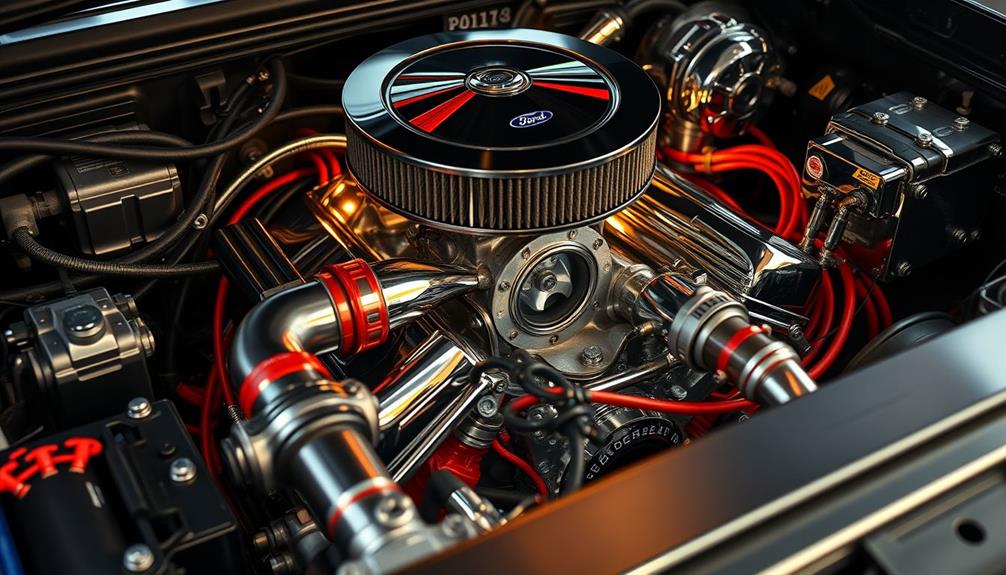
Boosting your Ford Lightning 2000's performance goes beyond just intake and cooling upgrades; fine-tuning the engine itself is vital.
To get the most out of your ride, consider these important modifications:
- Upgrade to a 2.76 pulley kit to increase boost levels, enhancing overall performance.
- Install a 6 lb lower pulley for potential gains of around 400 rwhp when properly tuned.
- Upgrade your fuel system with larger fuel injectors, such as 60 lb injectors, to guarantee adequate fuel flow.
- Add twin Walbro 255 fuel pumps to greatly improve fuel delivery under increased horsepower conditions.
- Perform a dyno tune after installing these modifications to optimize engine performance and maintain reliability.
Higher boost levels require careful tuning to prevent engine damage, so don't overlook this vital step.
Using aftermarket tuners like SCT or Diablo Sport can provide gains of 30-70 hp at the wheels, transforming your Lightning into a true powerhouse.
Exhaust System Upgrades
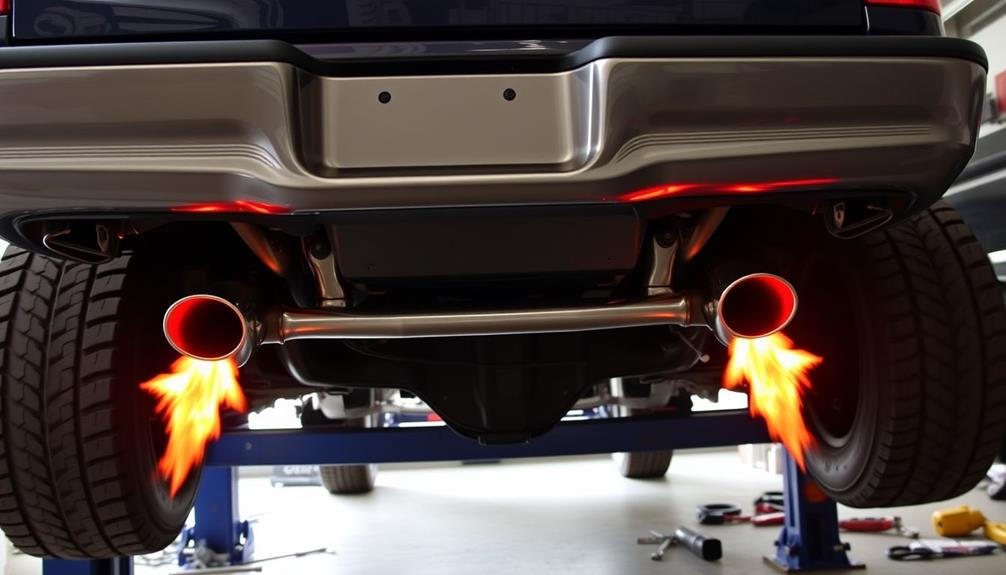
Upgrading the exhaust system on your 2000 Ford Lightning can considerably enhance performance and sound. By improving airflow and reducing back pressure, you can gain an impressive 15-25 horsepower. For ideal results, consider installing long-tube headers along with Bassani Mid Pipes and a quality cat-back exhaust, like Magnaflow. These upgrades not only boost performance but also give your Lightning that aggressive growl you desire.
Here's a quick comparison of popular exhaust upgrades:
| Upgrade Type | Performance Gain (hp) | Sound Enhancement |
|---|---|---|
| Shorty Headers | 10-15 | Moderate |
| Long-Tube Headers | 15-25 | Aggressive |
| Cat-Back Exhaust | 5-10 | Deep and throaty |
| Full Exhaust System | 20-30+ | Loud and powerful |
Weight Reduction Strategies
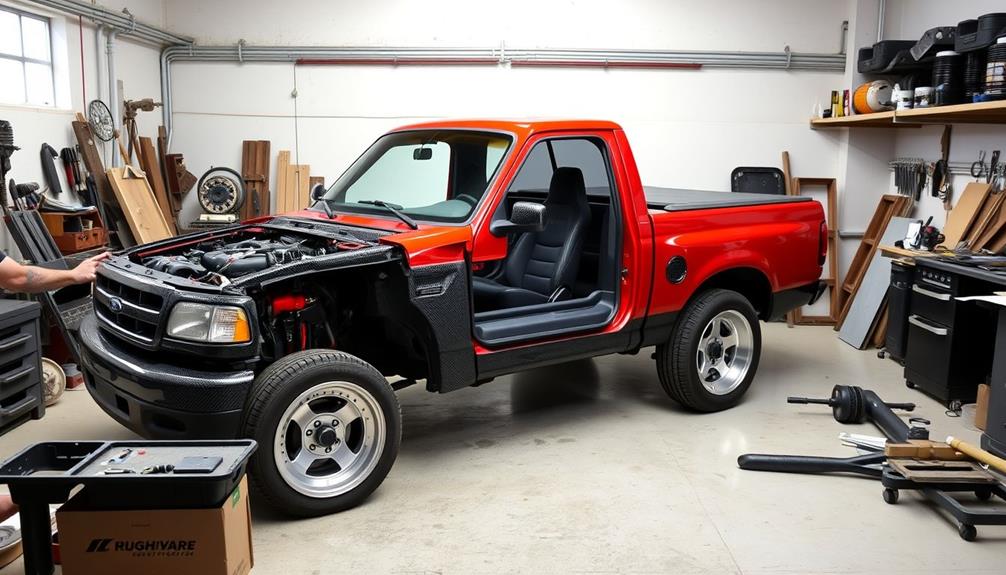
If you want to boost your Ford Lightning's performance, weight reduction is key.
By removing components like the passenger seat and spare tire, you can greatly enhance acceleration and handling.
Let's explore which parts to evaluate shedding and how these changes impact your performance metrics.
Benefits of Weight Reduction
Reducing weight in your Ford Lightning can lead to remarkable improvements in performance. By shedding approximately 200 pounds, you could shave 2-tenths off your ET during acceleration. This weight reduction not only enhances speed but also boosts stability and cornering capabilities, making your ride more agile and responsive.
Here are some benefits of weight reduction:
- Improved acceleration: A lighter vehicle accelerates faster, giving you quicker response times.
- Enhanced handling: Less weight allows for better cornering dynamics, improving overall driving experience.
- Increased traction: Removing components like the front antiroll bar can aid in weight transfer, enhancing traction at the rear tires.
- Reduced wear: A lighter truck exerts less stress on suspension components, prolonging their lifespan.
- Better fuel efficiency: Less weight typically means better gas mileage, saving you money in the long run.
Incorporating weight reduction strategies, such as removing the passenger seat or tailgate, can transform your Ford Lightning into a high-performance machine.
As you implement these changes, you'll also notice how traction bars can further optimize your pickup's grip and handling on the track.
Key Components to Remove
To release the full potential of your Ford Lightning, consider removing key components that can notably lighten your truck. By eliminating the passenger seat, center console, tailgate, and spare tire, you can easily shed around 200 pounds. This weight reduction greatly enhances acceleration and handling performance, making your truck more responsive during performance driving.
Additionally, implementing a well-planned budget for these modifications is essential to guarantee you allocate funds effectively for the best results, especially when considering budgeting for modifications.
In addition to these components, think about removing the front antiroll bar, which can save approximately 20 pounds. This modification aids in increasing front end rise and improves weight transfer during launches, allowing for faster quarter-mile times.
Each pound of weight you remove contributes to better overall vehicle dynamics, making your Lightning agile and lively on the road.
Don't overlook investing in lightweight components, like an aluminum driveshaft. This can decrease rotating weight, further enhancing acceleration and responsiveness in your high-performance pickup.
Impact on Performance Metrics
Weight reduction strategies have a direct and measurable impact on the performance metrics of your Ford Lightning. By removing excess weight, you can greatly enhance speed and handling, with estimates suggesting that every 200 pounds you shed can cut around 2-tenths off your ET.
This means your truck can accelerate faster and corner better, improving your overall driving experience.
Here are some effective weight reduction strategies:
- Remove the passenger seat: This can save around 50 pounds.
- Eliminate the center console: Another 20-30 pounds can go here.
- Take off the tailgate: This lightweight component can save about 40 pounds.
- Get rid of the spare tire: This can drop an additional 30-40 pounds.
- Remove the front antiroll bar: This saves 20 pounds while improving traction.
Focusing on these weight reduction strategies is essential, especially when you've made other performance enhancements.
A lighter truck can better utilize increased horsepower from tuning, leading to improved performance metrics overall. By prioritizing weight reduction, you'll maximize your Ford Lightning's potential on the road or track.
Suspension and Handling Improvements
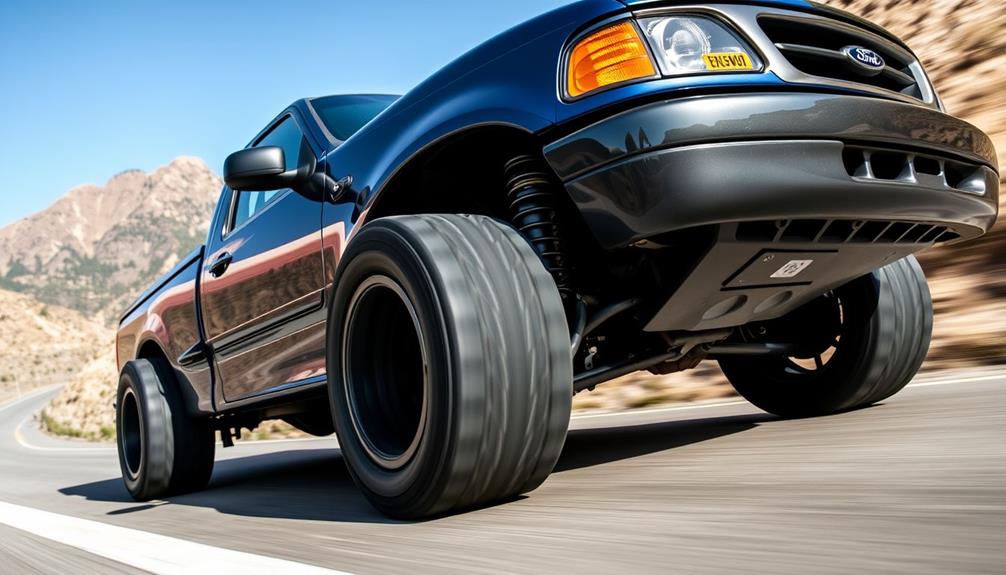
Upgrading the suspension on your 2000 Ford Lightning can dramatically transform its handling and stability. Improved suspension components, like performance shocks and springs, enhance stability during acceleration and boost overall handling characteristics. Adjustable sway bars can effectively reduce body roll, optimizing weight transfer and traction during launches and cornering.
Here's a quick overview of key suspension upgrades:
| Upgrade Type | Benefits | Recommended Products |
|---|---|---|
| Performance Shocks | Enhances stability and control | QA1 Drag Shocks |
| Adjustable Sway Bars | Reduces body roll, improves suspension geometry | Bell-Tech Shackles |
| Lowering Kits | Alters pinion angle, boosts traction | Bell-Tech Shackles |
| Drag Shocks | Maximizes traction during hard launches | QA1 Drag Shocks |
Installing drag shocks, such as those from QA1, helps maximize traction by slowing rear axle housing reaction, allowing for better grip on the tires. Additionally, lowering the truck's rear with Bell-Tech Shackles improves handling dynamics under load. These performance modifications can lead to quicker quarter-mile times, ensuring your Lightning performs at its best.
Tire and Traction Optimization
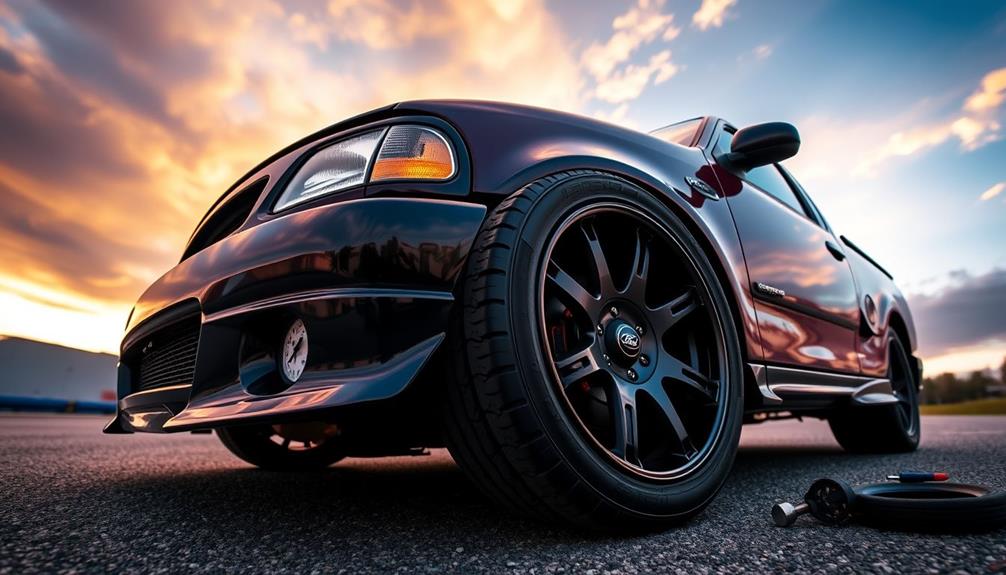
Enhancing your 2000 Ford Lightning's handling isn't just about suspension upgrades; tire choice plays a pivotal role in optimizing performance. The right tires can greatly improve traction, especially during launches and cornering.
Here are some tips to take into account for tire and traction optimization:
- Opt for wider performance tires to boost grip and enhance overall handling.
- Think about sticky rear tires, like Mickey Thompson 16-inch ET Street Tires, for superior off-the-line acceleration and quarter-mile success.
- Utilize drag radials from brands such as Nitto and BFGoodrich; they mix street tire traits with enhanced traction, making them perfect for both street and track.
- Install skinny front tires to reduce rolling resistance, which can shave precious tenths off your quarter-mile times.
- Prioritize regular tire maintenance; guarantee proper inflation and alignment to maximize traction and performance in high-power scenarios.
Transmission Modifications
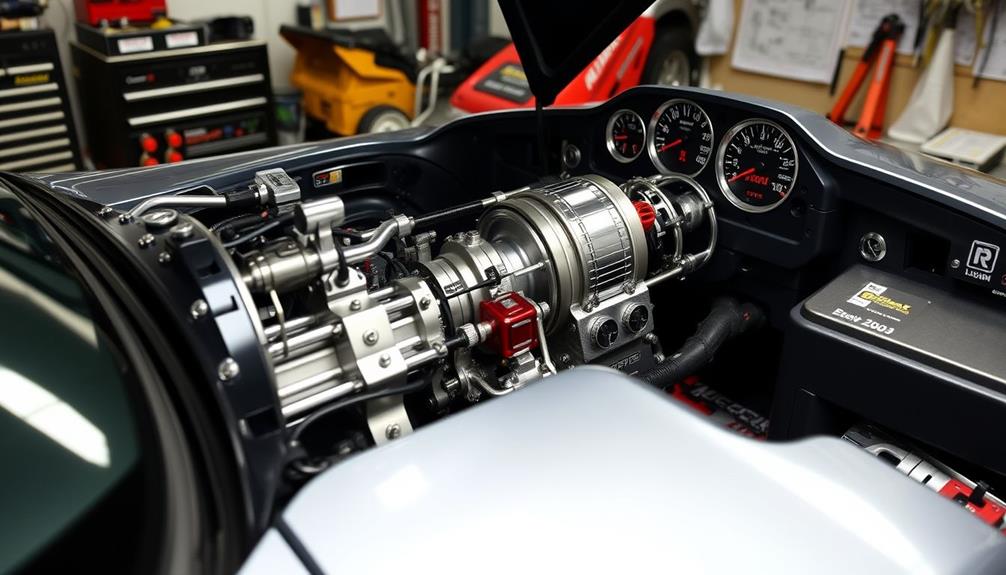
When it comes to maximizing the performance of your 2000 Ford Lightning, transmission modifications are vital. The stock 4R100 transmission can handle up to 360 hp, but common failures in the front pump and Overdrive band can hinder your power gains. Upgrading to an LFP Stage 2 Rebuild Kit is a smart move, as it enhances reliability under increased horsepower conditions, ensuring your transmission can keep up with your performance upgrades.
One of the most effective transmission modifications you can make is installing a Shift Kit. This valve body upgrade raises line pressure, resulting in quicker, crisper shifts during hard acceleration. Not only will you feel the difference in responsiveness, but it'll also help protect your transmission from excessive wear.
Additionally, consider adding a deep sump transmission pan, which increases fluid capacity by up to 3 quarts. This improvement helps maintain cooler transmission temperatures, considerably prolonging its lifespan.
Fuel System Enhancements
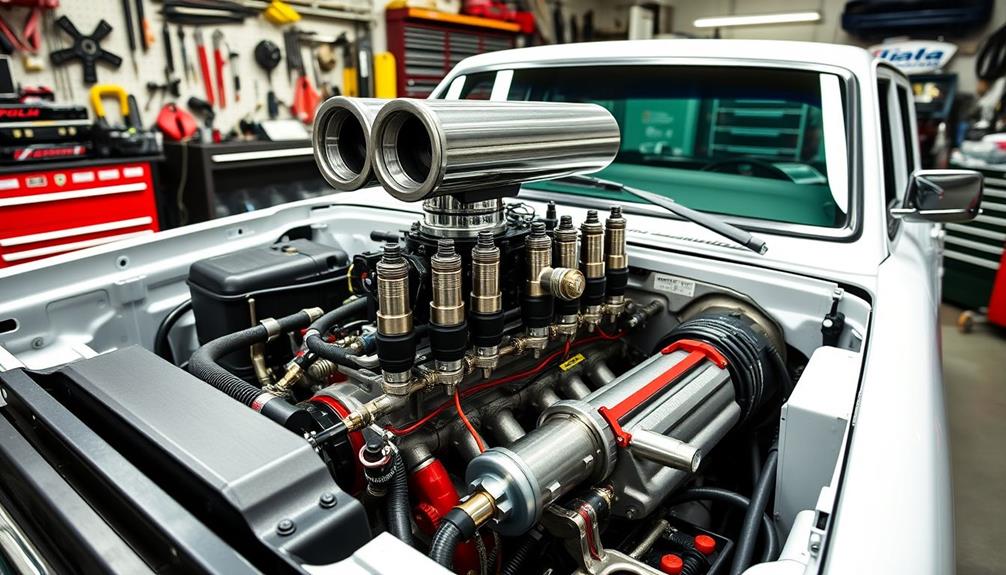
When you're looking to boost your Ford Lightning's power, upgrading the fuel system is essential.
Consider installing twin Walbro 255 pumps and 60lb injectors to guarantee your engine gets the fuel it needs.
Pairing these with a rail-mounted fuel pressure regulator will keep everything running smoothly under high-performance conditions.
Fuel Pump Upgrades
Upgrading the fuel system in your 2000 Ford Lightning can greatly boost performance, especially if you're aiming for higher horsepower levels. One of the most effective enhancements is to install twin Walbro 255 fuel pumps. These pumps improve fuel delivery and can support up to 500 bhp efficiently.
To maximize your fuel system upgrade, consider the following points:
- Install 60 lb injectors along with '97 style fuel rails for increased fuel flow.
- Use a rail-mounted fuel pressure regulator to manage fuel pressure effectively.
- Verify compatibility between new pumps and the OEM fuel system to avoid incorrect fuel pressures.
- Replace the fuel filter to maintain clean fuel delivery and protect your engine.
- Upgrade to larger fuel lines to accommodate the increased fuel demands from modifications.
Also, remember that if you're running a lower pulley for added boost, your fuel system must be up to the task.
Injector and Regulator Optimization
Optimizing your injectors and fuel pressure regulator is vital for maximizing performance in your 2000 Ford Lightning. Upgrading to 60lb injectors is highly recommended, especially when you're pushing higher boost levels and horsepower. These injectors guarantee sufficient fuel flow, preventing lean conditions that can damage your engine.
In addition to the injectors, installing a rail-mounted fuel pressure regulator can greatly enhance your fuel management. This regulator maintains consistent fuel pressure, which is critical for high-performance applications.
To further support your power goals, consider using twin Walbro 255 fuel pumps. These pumps deliver improved fuel flow and effectively handle power levels up to 500bhp without return issues.
It's important to check the compatibility of your new pumps with the OEM fuel pressure regulator. This confirms you maintain proper fuel pressures, especially in demanding scenarios.
You may also need to upgrade to larger fuel lines to accommodate the increased fuel demands of your modified engine setup. These enhancements will work together to optimize your fuel system, guaranteeing your Lightning performs at its best on the road or the track.
Frequently Asked Questions
How Much HP Can a Stock Ford Lightning Handle?
A stock Ford Lightning can handle around 500 rwhp without significant risk of damage. However, exceeding this limit requires careful tuning and modifications to maintain performance and prevent engine failure, especially if increasing boost.
How Much HP Does a 2000 Ford Lightning Make?
Wondering how much horsepower a 2000 Ford Lightning delivers? It typically produces around 360 horsepower with stock configurations. With the right modifications, you can release even more power, enhancing your high-performance experience considerably.
How Much Power Can a Ford Lightning Make?
A Ford Lightning can reach impressive power levels, with stock models around 360 hp. By adding aftermarket modifications and proper tuning, you might push it to 400 hp or more, depending on your upgrades and tuning approach.
Can You Supercharge a Ford Lightning?
Imagine feeling the rush as your truck roars to life. Yes, you can supercharge your Ford Lightning, boosting its power considerably. Just remember, proper tuning and modifications are essential for ideal performance and reliability. When it comes to increasing the performance of your Ford Lightning, proper tuning and modifications are just as important as they are for any vehicle. Whether you’re looking to boost horsepower, improve fuel efficiency, or enhance overall driveability, investing in Ford Lightning tuning is a smart choice. Just like with Ford Escort tuning, proper tuning and modifications can take your truck to the next level and ensure that it performs exactly how you want it to.
Conclusion
By tuning your Ford Lightning 2000, you can release its full potential, enhancing both performance and driving experience. Did you know that with proper modifications, you could see power gains of up to 30%? That's not just a number; it means quicker acceleration and better handling on the road. So, whether you're hitting the track or just cruising, these upgrades will transform your pickup into a true powerhouse that stands out from the crowd.
